 |
||
|
||
| ||
Chinese $150 Linux Mini-PC Races OLPC To Market Rat Nerve Cell Pings Computer Chip Purse Won't Let You Forget Keys Reprogrammable Coprocessors For Any Opteron Server New Motherboards And A Mini-PC From Albatron Albatron Introduces GeForce 7900GTX512, Other Novelties Chinese $150 Linux Mini-PC Races OLPC To Market A Chinese company is touting an inexpensive Linux-based computer as a way to close the "digital divide." YellowSheepRiver's $150 "Municator" appears to be available now, with a three-month leadtime, suggesting it could reach market well ahead of MIT's $100 "One Laptop Per Child" (OLPC) device. The OLPC project was announced last fall, with laptop manufacturer Quanta Computer of Taiwan stepping forward to offer its manufacturing services shortly afterward. However, no specific delivery commitments appear to have been reached. YellowSheepRiver says it saved cost in its Municator YSR-639 design by sourcing the CPU, RAM, and other key chips from Chinese companies. China is now the world's third-largest producer of new semiconductor designs, according to research firm iSuppli. According to YellowSheepRiver, the Municator is based on a 64-bit Godson-2 CPU from BLX Semiconductor. The Godson-2 chip, codenamed "Dragon," uses an instruction set based on the MIPS architecture; however, BLX is not a MIPS licensee. The Microprocessor Report suggested last summer that BLX could face legal challenges from MIPS if its chips reach the U.S., although some other sources suggest that the Godson chips do not include patented portions of the MIPS ISA (instruction set architecture), such as unaligned 32-bit load/store support.  The Municator's Godson-2 processor offers performance similar to a Pentium III, YellowRiver claims; however, a more useful comparison might be to MIPS's four-way superscalar R10000 processor, which shipped in 1995, and powered Silicon Graphics Unix workstations such as the O2, pictured at right. The Godson-2 also has a four-way superscalar design. The Godson-2 chips in YellowSheepRiver's YSR-639 are clocked at 400MHz or 600MHz. They connect to a Marvel MV64420-BDM1C133 northbridge via a 133MHz FSB (front-side bus). The Marvel northbridge supports DDR RAM at 166MHz, via an SODIMM slot, and offers a 32-bit, 33MHz PCI bus. A VIA VT82C686B southbridge with 133/100/66MHz ATA bus completes the chipset. YellowSheepRiver says it hopes one day to use an "SoC" (system-on-chip) version of the Godson-2 chipset that will integrate the processor and northbridge into a single chip, and save additional cost and power. The OLPC design eschews a hard drive, to keep cost down, but has an LCD display. The Municator, in contrast, offers an S-video port, in order to support television displays, and comes with a 40GB external USB drive. The Municator also has rear-mounted IDE and power connectors that support the attachment of optional optical drives.  Other interfaces, according to YellowSheepRiver, include four front-mounted USB 2.0 ports, IrDA, and audio I/O. Additional rear-mounted interfaces include S-video, VGA, 10/100 Ethernet, serial, PS/2 keyboard/mouse, and IDE. The Municator measures 7 x 5.7 x 1.5 inches (180 x 145 x 37mm), and weighs one pound, six ounces (0.65kg). It requires five amps of 12-volt power, and comes with a 45-watt auto-sensing 110/220 adapter. A lithium-ion battery pack is optionally available. Other options include WiFi and a modem. The Municator runs "Thinix 3.0," a Linux variant that features support for user interfaces based on a keyboard, mouse, or both, according to YellowSheepRiver. Thinix is based on RPLinux, a distribution created by the China Software and Integrated Circuit Promotion (CSIP). YellowSheepRiver says orders for its "Fitness Computer," possibly a codename for the YSR-639, can begin production within three months of order confirmation. Source: LinuxDevices
Rat Nerve Cell Pings Computer Chip A rat nerve cell attached to a semiconductor chip has exchanged a signal with the chip, an achievement that could lead to organic computers that process information like a brain, say researchers. In the long term, the technology also could lead to prosthetic limbs that are controlled by a person's brain and nerves. "If you know how single neurons couple to a chip, you can learn how whole tissue couples to a chip," said Peter Fromherz, professor of biophysics at Max Planck Institute for Biochemistry in Germany and coordinator of the so-called NaChip project, which also involves researchers from the University of Padua, Italy, and the University of Zurich, Switzerland. 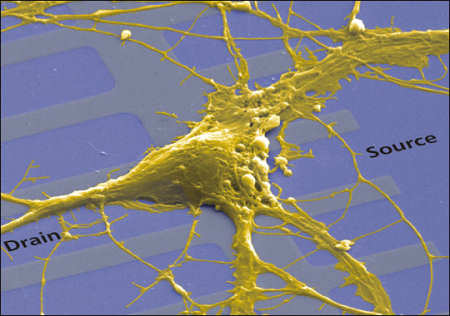 To make the nerve cell and the chip compatible, the researchers worked with German microchip company Infineon to modify the chip's surface. The resulting one-millimeter chip has more than 16,000 transistors that match up with ion-carrying channels in the nerve cell. The chips were specially coated so that they could be immersed in a solution meant to keep the nerve cell alive. Next, the team zeroed in on the protein fibronectin, which is involved in many cellular processes, including tissue repair, blood clotting, and cell adhesion. The scientists grew the nerve cell on the protein and then used the protein to adhere the nerve to the silicon chip. In addition to helping the cell adhere, the protein also served as a gate through which charged particles of sodium — the "Na" in NaChip — could move between the nerve and transistor. By measuring the charge on the chip, the scientists confirmed that the electrical pulses from the active neuron were finding their way to it. They were also able to stimulate the nerve cell by sending an electrical pulse from the chip's capacitors. "From a major technology breakthrough point of view, the technique will revolutionize the way it's done," said professor Naweed Syed, head of the department of cell biology and anatomy at the University of Calgary. Eventually, the NaChip team plans to move beyond the single rat cell to rat brain. According to Fromherz, the scientists have all of the tools to couple hundreds of neurons to a semiconductor chip and conceivably perform simple computations. Source: Discovery News
Purse Won't Let You Forget Keys A new kind of fabric purse can detect its contents and alert the owner when something is missing. The Ladybag, aimed at young professional women, could put an end to leaving the house without the cell phone, house keys, or wallet.  "We are a group of six women on the team. We came up with the bag idea because we thought that all of us would use it," said team member Ginny Mesina, a senior at Canada's Simon Fraser University. Mesina and the team, including Sherry Li, Nasrin Roya, Huma Zaidi, Lillian Tam, and Jenny Vi, developed the idea as part of a course project, which placed students from the university's interactive arts degree and the information technology degree together. To design the purse, the students used off-the-shelf technology. Into the bottom of the bag they embedded a radio frequency identification reader, which is powered by a nine-volt battery. Source: Discovery News
Reprogrammable Coprocessors For Any Opteron Server The Register has a fairly in depth look at one start-up's attempt to capitalize on AMD's HyperTransport interface - a reprogrammable coprocessor that can drop into any Socket 940 socket. The company, DRC, built its programmable coprocessor on Xilinx Virtex4 field programmable gate array integrated circuits.  For specialized industries, a dynamic coprocessor is exactly what the doctor ordered; low overhead for extremely specific tasks such as vector math or collision detection. Companies already pay thousands to millions of dollars to have such overly specific algorithms ported to custom FPGA processors, but the kicker for DRC is that the chip can be integrated into a multi-slot Opteron server running the correct software. Each series of coprocessors unveiled by the company uses the standard HyperTransport (HT) interface to communicate with the main processor. The low end coprocessor, the DRC100-L60ES, uses a 200MHz by 8-bit HT link. DRC's two high-end modules, the DRC100-L60 and the DRC110-L160 both use a 400MHz by 16-bit interface instead. DRC coprocessors range in size from 50,000 to 140,000 programmable gates and all three can utilize 6.4GBps between the Xilinx FPGA and the DDR400 memory bank. Each DRC module starts at about $4,500. Competing proprietary systems from SGI and IBM easily cost four times that and generally require additional proprietary hardware and contracts to support. Source: DailyTech
According to DigiTimes that refers to Apple Daily, ASUS is to introduce its first tablet PC - R1 - not before May-June this year. At CeBIT 2006 this device (codenamed R1F) was promised a month earlier, in April-May. 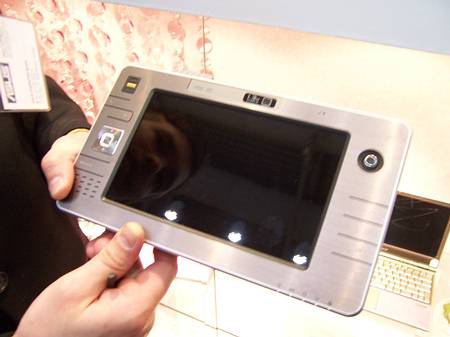 This 7" device, that some online sources correlate to Origami, bases on Intel Celeron ULV and Intel 915 GMS chipset and has 512MB RAM. Whether it's Origami or not, it will be the first tablet in ASUS's portfolio. Source: DigiTimes, iXBT.com, WinFuture.
New Motherboards And A Mini-PC From Albatron Besides graphics cards, Albatron also announced several motherboards. Firstly, the new flagship mainboard, the PX975X, supporting Extreme Edition processors and dual graphics configurations. The PX975X also uses a Digital Clock generator to adjust frequencies for clocks located within the system. 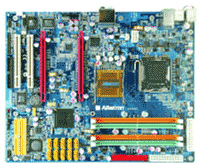 The PX975X has dual power supply connectors and offers ten SATA II ports and six IDE interfaces supporting RAID 0, 1, 0+1 and 5. The PX975X also features 8-channel High Definition Audio, Broadcom Gbit LAN and ABS (Albatron BIOS Security). The second motherboard novelty is the new KM51PV-AM2 following in the footsteps of semiconductor giant AMD's leap into the world of integrated DDR II memory controllers for K8 processors. Albatron's KM51PV-AM2 features NVIDIA's GeForce 6150 chipset with integrated graphics engine and supports AM2 processors. 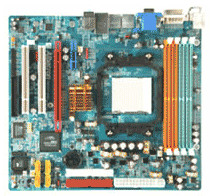 The KM51PV-AM2 offers built-in D-sub, DVI, TV-out and HDTV interfaces. Also included are four SATA II channels with RAID. Another two motherboards to be launched are the PXP965 and the PXG965, both geared towards Intel's next-generation Conroe processor. The PX965 uses the Intel P965/ICH8 chipsets while the PXG965 uses the Intel G965/ICH8 chipsets. The G965 integrates Intel's 4th generation graphics engine. Both chipsets support the latest DDRII technology with speeds up to 800MHz and maximum bandwidths to 12.8 GB/s. 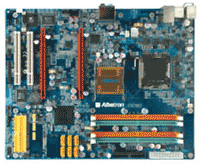 Both motherboards offer one PCI-E X16 slot, one PCI-E X1 slot and one Universal PCI-E slot. Also integrated onto them are Broadcom Gbit LAN and a RealTek audio codecs for 8-channel High Definition Audio Technology. Both also contain Albatron's own ABS (Albatron BIOS Security) system as an option. The new Intel ICH8 Southbridge chipset features support for two more SATA II interfaces compared to previous ICH7 implementations. The ICH8 also can support two more USB ports (total of 10). Although this new Southbridge no longer supports IDE interfaces, Albatron has integrated 3rd party IDE solutions for those users who want to upgrade using existing IDE hardware. The next novelty is the new KI51PV mainboard based on NVIDIA's GeForce 6150 chipset with integrated graphics supporting PureVideo technology. The KI51PV's small form factor (Mini-ITX) is perfect for a wide range of specific-use applications such as Consumer Electronics, IPCs, Automobiles, POS systems, DIY enthusiast systems etc. 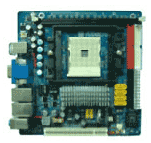 The KI51PV supports AMD's Athlon 64, Sempron 64 and Turion 64 CPUs. It also contains one DDR 333/400 MHz DIMM slot for a total memory capacity of up to 1GB. Also onboard is Dual Gbit PHY, eight USB 2.0 ports (4 by header), four SATA II ports (with RAID) and two IDE channels. Also included is support for DVI in addition to TV-out, D-Sub and optional support for YPbPr. Finally, the company introduced its new Mini-PC sized 224x160x50mm. The machine employs an Intel Core Duo CPU along with Intel 945GT chipset that comes with GMA950 graphics engine running at 400MHz. It also includes the latest DivX and WMV9 video decoders and integrates 8 channel audio effects as well as a TV-out connector. The Mini-PC is compatible with the Microsoft Windows Media Center Edition and Intel VIIV technology. 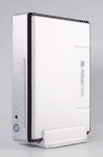 Other features include six USB ports and one 1394 port, an optional Wireless LAN (Albalink) and Bluetooth kits, a 3-in-1 card reader (SD/MS/MMC). At all that, the Mini-PC produces noise under 30dBA. Source: Albatron
Albatron Introduces GeForce 7900GTX512, Other Novelties Albatron recently announced its most powerful VGA card ever, the GeForce 7900GTX512, featuring NVIDIA's top-end GPU, the GeForce 7900 GTX. The 7900GTX512 card features 512MB of 256-bit DDR3 clocked at 1600MHz. The card's core is rated at 650MHz and was engineered using 0.09 micron process technology. It includes 24 pipelines and supports SLI configurations. 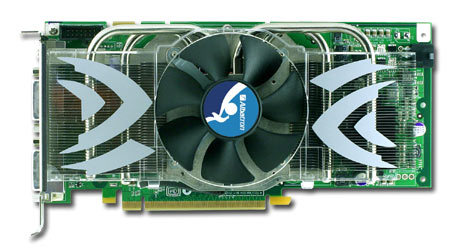 The NVIDIA GeForce 7900 GTX GPU is also equipped with Intellisample 4.0, Ultrashadow II and CineFX 4.0. This GPU also features NVIDIA's PureVideo, a full featured video encoder/decoder for a variety of formats including HDTV. The 7900GTX512 will provide Dual DVI connectors. The bundle package will include HDTV, S-Video and AV adapters. 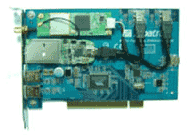 The second novelty is Albatron MFE (Multi-Functional Extension) card. This new card provides Wireless (802.11b/g) and a TV tuner (DVB-T MPEG-2) functionality as well as Firewire ports and occupies a single PCI slot. Ok, the next product is an Albatron 7600GT graphics card based on the G73 GPU. The engine core is rated at 560MHz and contains 12 pipelines. This card also has 256MB of DDR3 memory with a 128-bit memory bus. The memory can clock up to 1.4GHz. 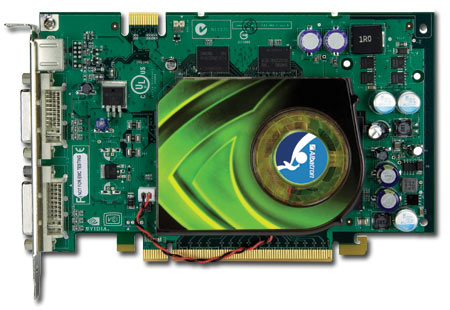 The 7600GT also comes packed with CineFX 4.0, Intellisample 4.0 and Ultrashadow II technologies. The 7600GT contains two independent 400MHz RAMDACs as well as Dual DVI connectors and a TV-Out. Source: Albatron
Write a comment below. No registration needed!
|
Platform · Video · Multimedia · Mobile · Other || About us & Privacy policy · Twitter · Facebook Copyright © Byrds Research & Publishing, Ltd., 1997–2011. All rights reserved. |